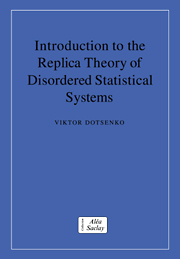Book contents
- Frontmatter
- Contents
- Preface
- 1 Introduction
- Part one Spin-glass systems
- Part two Critical phenomena and quenched disorder
- Part three Other types of disordered system
- 11 Ising systems with quenched random fields
- 12 One-dimensional directed polymers in random potentials
- 13 Vector breaking of replica symmetry
- 14 Conclusions
- Bibliography
- Index
14 - Conclusions
Published online by Cambridge University Press: 08 September 2009
- Frontmatter
- Contents
- Preface
- 1 Introduction
- Part one Spin-glass systems
- Part two Critical phenomena and quenched disorder
- Part three Other types of disordered system
- 11 Ising systems with quenched random fields
- 12 One-dimensional directed polymers in random potentials
- 13 Vector breaking of replica symmetry
- 14 Conclusions
- Bibliography
- Index
Summary
In this book we have studied various effects produced by quenched disorder on thermodynamical properties of statistical systems. Considering different types of model, the emphasis has been made on the demonstration of the basic theoretical approaches and ideas. Although the considered systems and the corresponding problems involved (such as spin glasses, critical phenomena, directed polymers etc.) may at first look quite different, the aim of the book was to demonstrate that basically all these problems are deeply interconnected. I was trying to convince the reader that to work successfully on any particular problem in this field one needs to be familar with all the methods and ideas of statistical field theory. The physics of both the spin-glass state and critical phenomena in weakly disordered systems involve the ideas of the scaling theory of phase transitions, and the basic concepts of the replica theory of spin glasses. The aim of this book was to take the reader, starting from fundamentals and demonstrating well-established solutions of various problems, to the frontier of modern research. Here we are facing quite a few fundamental problems, both long-standing and new ones, still waiting for their solutions.
The most appealing problem in the scope of spin glasses had remained a question for almost two decades: whether or not the mean-field RSB physical picture (described in Chapters 2–6) is valid, at least at the qualitative level, for realistic spin glasses with finite-range interactions.
- Type
- Chapter
- Information
- Publisher: Cambridge University PressPrint publication year: 2000

